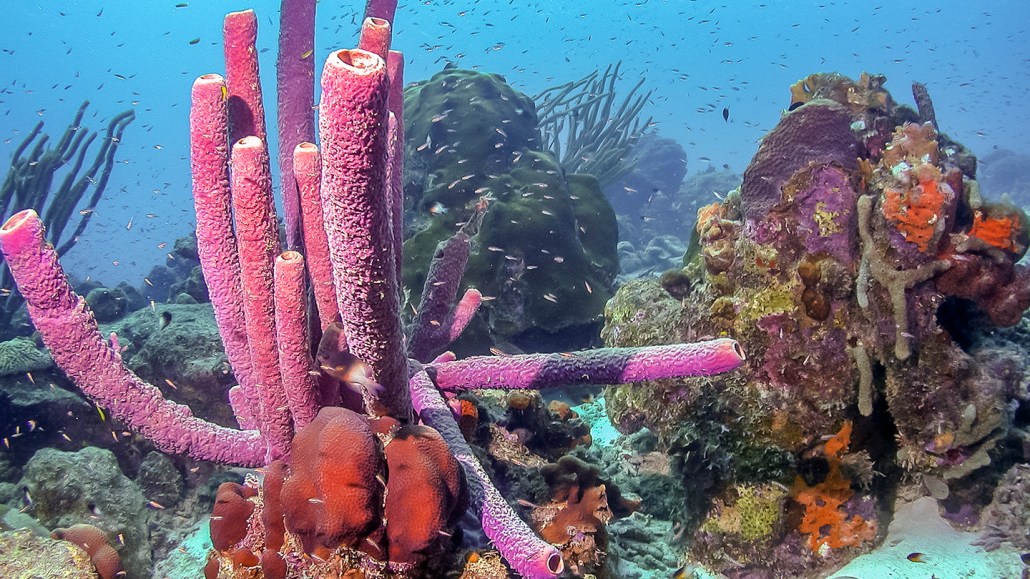Sea sponges spew slow-motion snot rockets to clear out their pores
The surprising way that sea sponges ooze debris-filled mucus emerged in time-lapse video

Sea sponges are probably the last animals you’d expect to catch sneezing. But a new study shows how some sponges, like this pink Caribbean tube sponge (Aplysina archeri), constantly “sneeze” out a snotty goo.
johnandersonphoto/iStock/Getty Images Plus
Share this:
- Share via email (Opens in new window) Email
- Click to share on Facebook (Opens in new window) Facebook
- Click to share on X (Opens in new window) X
- Click to share on Pinterest (Opens in new window) Pinterest
- Click to share on Reddit (Opens in new window) Reddit
- Share to Google Classroom (Opens in new window) Google Classroom
- Click to print (Opens in new window) Print
By Jude Coleman
Next time you spot a sea sponge, say “bless you!” Some sponges regularly sneeze to clear debris from their bodies, new research shows.
Sea sponges are simple creatures that sit on the seafloor. They eat by drawing water through the many holes, or pores, on their surfaces. A system of canals inside the sponge strains that water for nutrients. But the water often contains debris — such as sediment — that sponges can’t digest.
Now, scientists have discovered how one species keeps that junk from clogging its pores. The Caribbean tube sponge (Aplysina archeri) uses mucus to trap and sneeze out unwanted particles. Surprisingly, the sponge blows snot from the same pores through which it absorbs water. Researchers shared this discovery online August 10 in Current Biology.
@sciencenewsofficial Sea sponges may be the last animal you’d expect to find sneezing, but time-lapse videos show they launch slow-motion snot rockets. #seasponges #animals #marinebiology #science #learnitontiktok
♬ original sound – sciencenewsofficial
It’s “like someone with a runny nose,” says team member Sally Leys. The sponge’s mucus is “constantly streaming.” Leys is an evolutionary biologist at the University of Alberta. That’s in Edmonton, Canada.
Sea sponges were known to contract their bodies in an action dubbed “sneezing.” But scientists thought sponges only did this to push water through their bodies in a one-way flow. Typically, water enters through a sponge’s pores and leaves through a hole near its top.
But time-lapse videos of A. archeri revealed a further effect of such sneezing. In the footage, Leys’ group saw tiny specks of mucus leaving the pores. This snot moved against the flow of incoming water. Sneezelike contractions seemed to expel and move the specks along a “mucus highway” on the surface of the sponge. This action gathered the mucus into stringy, gooey clumps.
Unlike an explosive human sneeze, the sponges continuously secreted debris-filled mucus from their pores. And those sneezes were slow. Just one contraction took between 20 and 50 minutes!
Other sea critters feasted on these ocean boogers. Brittle stars snacked on them. So did small crustaceans. Scientists often think of sponges mainly as habitat builders. But the mucus buffet shows they also play a key role as providers of food, says Amanda Kahn. This marine biologist was not involved in the study. She works at Moss Landing Marine Labs in California.
“There’s so much to be said for a study that really spends time and watches,” Kahn says. Leys’ team “let the animals show for themselves what was happening.”
Most sponges are thought to sneeze to flush water out of the holes at the tops of their bodies. So this A. archeri probably isn’t the only one to sneeze mucus out of its pores, too, Leys says. Her team has seen an Indo-Pacific sponge (Chelonaplysilla sp) do something similar. But biologists need to dig deeper to figure out how widespread this type of sponge-sneezing is.







